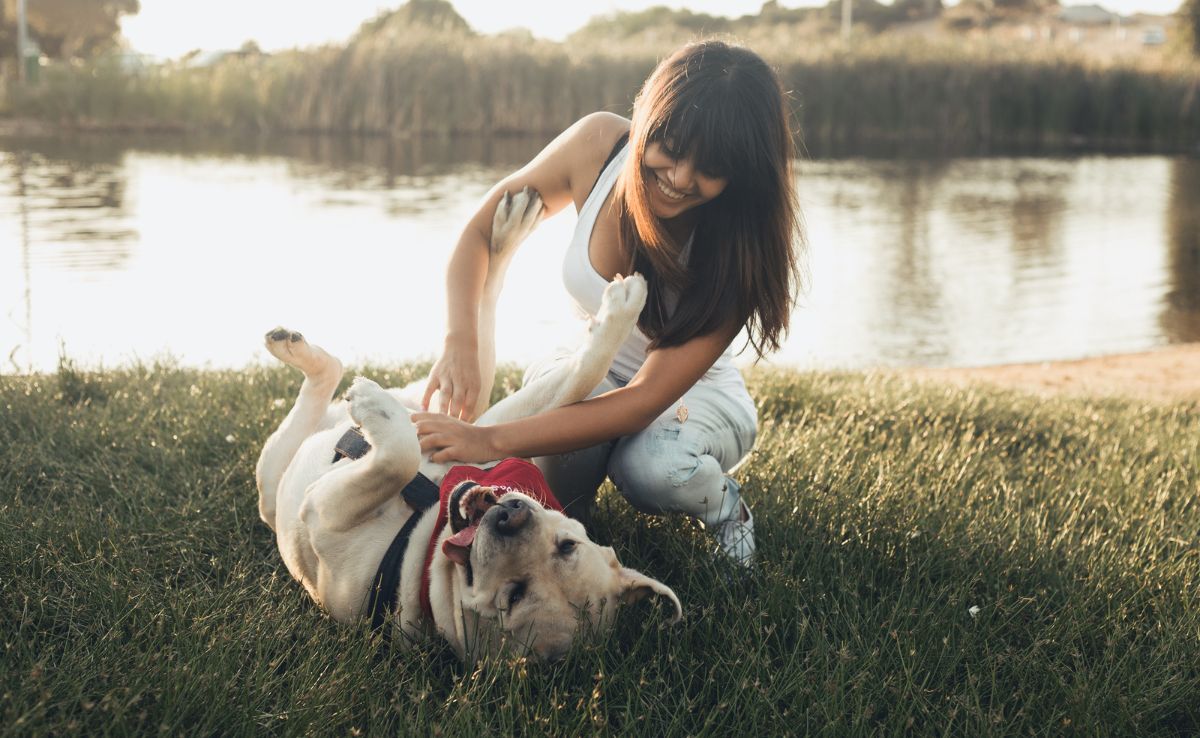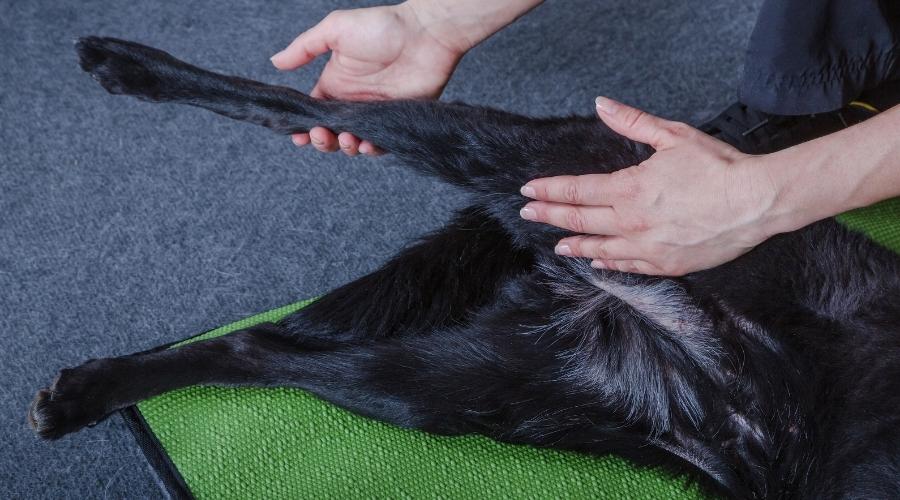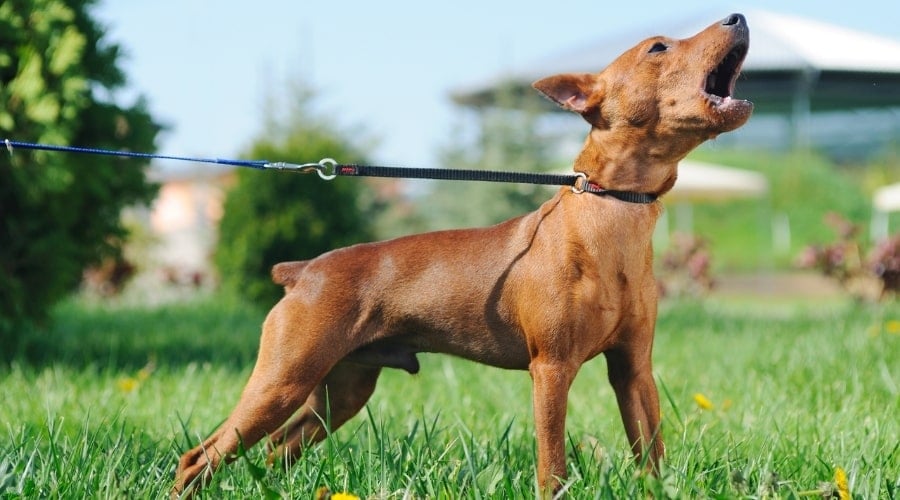Wait… Dogs Can Be Ticklish?! What Happens When You Find The Spot!
When you purchase through links on our site, we may earn a commission. Here’s how it works.
Ever scratched your dog’s belly and watched their leg twitch like they’re starting a lawnmower? There’s a wild reason behind it. Your dog might actually be ticklish.
Table of Contents
If you’ve ever caught your pup mid-scratch-session, leg flailing and eyes full of betrayal, you’re not alone. Dog parents everywhere are asking the same hilarious question: are dogs ticklish? And honestly, the answer might surprise you. From belly rubs that trigger kick combos to mysterious paw twitches, there’s more to your dog’s reaction than just loving the attention.
In this article, I dig deep into dog ticklishness, why dogs react the way they do, what it really means, and whether it’s just a reflex or something closer to our own giggle fits. Backed by expert insight and behavioral science, I’ll help you decode your dog’s strange (and adorable) responses so you can bond better, scratch smarter, and maybe stop getting kicked in the face.

Are Dogs Ticklish? What Science & Behavior Reveal
Yes, dogs can be ticklish, just like people, primates, and many other mammals. Research from Sweden’s Karolinska Institute shows that humans and dogs experience two distinct types of tickling:
- Knismesis. This is the light, feathery tickle. Think of the sensation of a bug crawling on your skin or a gentle brush that makes you twitch. It often causes an itchy feeling or a mild reflexive reaction.
- Gargalesis. This one’s the laugh-inducing kind, triggered by deeper pressure on specific spots. In humans, it usually causes uncontrollable laughter. In dogs? It might trigger a dramatic leg kick or a goofy squirm, but no giggles (at least not that we can hear).
So when you scratch your pup’s belly and their back leg starts revving like a lawnmower, you’re likely triggering one of these ticklish responses.
Reflex Or Emotion? What That Kick Really Means
While dogs don’t laugh like we do, that doesn’t mean their reaction is purely mechanical. The infamous “scratch reflex” is a neurological response to touch. An automatic movement designed to protect them from irritants like bugs or grass. But many dog owners notice their pups seem to enjoy it, even asking for more.
That’s where the line between reflex and enjoyment gets fuzzy. Scientific studies and some experts believe that repeated positive experiences with certain kinds of touch may lead dogs to associate that sensation with pleasure, not just instinct.
What The Experts Say
Veterinary behaviorists confirm that dogs’ ticklishness varies widely. Some dogs have extremely sensitive spots, like their belly, chest, or paws, while others do not respond. Breed, age, past experiences, and individual temperament all play a role.
So, can dogs be ticklish? Absolutely. However, how they react and whether they enjoy it are unique to each dog. What’s clear is that your dog’s quirky kick, wiggle, or joyful flop onto their back is a fascinating combo of instinct and potential enjoyment.
Can Dogs Be Ticklish Like Humans? A Look At The Reflex vs. Feeling Debate
So we’ve established that dogs react to touch. Especially in sensitive spots like their belly, paws, or sides. But here’s the real question dog owners want answered: can dogs actually feel ticklish the way we do, or is it just an automatic reflex?

Reflex Or Real Feeling?
The primary reaction most dog owners notice is the scratch reflex. That sudden leg kick when you hit the spot. This response is triggered by nerve endings just under the skin and it’s involuntary. It’s similar to how humans might flinch when touched unexpectedly or feel an itch they have to scratch. In that sense, it’s more of a protective reflex than a conscious reaction to being tickled. And sometimes, the automatic response we have to pull away from what’s causing the tickling helps protect us.
But here’s where it gets interesting: not all dogs react the same way. Some actively seek out the sensation, rolling onto their back and nudging your hand if you stop. Others might squirm away or show signs of overstimulation.
This inconsistency has led veterinary behaviorists and canine researchers to suggest that while dogs likely don’t experience ticklishness in the same emotional way humans do, they can still form positive emotional associations with specific types of touch over time. Especially when paired with affection, routine, and comfort.
The Human-Dog Gap
Humans experience gargalesis (the deep, laughter-inducing kind of tickle) as part of our social bonding. It’s why we laugh when friends poke us, even when we want them to stop. Dogs, on the other hand, don’t display laughter-like behavior from tickling. But they do show signs of pleasure, comfort, or tolerance, depending on the context and the individual dog.
In short: dogs likely don’t feel ticklish in the “giggle and laugh” kind of way, but that doesn’t mean they’re not enjoying it. Their reactions are a mix of instinct, learned experience, and emotional bonding.
How To Tell If Your Dog Is Ticklish
Wondering if your dog has a secret ticklish spot? You’re not alone. While dogs can’t tell us directly, their bodies give away more than a few clues. The key is knowing what to look for and what not to confuse with other reactions.
Common Signs Your Dog Might Be Ticklish
Research has found that tickling stimulates both the touch and pain nerve endings in the skin. This may help explain why some people find tickling unbearable. Is the same true for some dogs? Our canine companions share our varying sensitivity and responses to tickling. Some dogs are simply more sensitive to touch than others.

Pay attention to your pup’s vocalization and body language to know if they like being tickled. Dogs don’t laugh as we do, but some animal behaviorists believe that dogs express happy panting as the equivalent of our laughter. This happy panting often follows initial signs of an open mouth, stretching from ear to ear, with their tongue hanging out slightly to one side.
Here are a few behaviors that may indicate your dog is reacting to touch in a ticklish (or tickle-like) way:
- Leg Twitching or Kicking: This is the big one. If your dog’s leg kicks out when you scratch a certain area, especially the belly or sides, that’s likely the scratch reflex in action.
- Wiggling or Rolling Over: Some dogs roll onto their backs and squirm when touched in sensitive areas, especially if they enjoy it.
- Quick Head Turns or Side-Eye: A surprised or playful glance may mean you hit a sensitive nerve, especially if paired with tail wagging.
- Tail Wagging or Butt Wiggles: If your dog seems happy and keeps coming back for more, they’re probably enjoying the sensation.
- Lifting a Paw or “Dancing” Feet: Most dogs have high paw sensitivity. A light touch here may make them react dramatically or pull away entirely.
How To Tickle A Dog
Find your pup’s tickle spots by lightly scratching or wiggling your fingers over different areas of their body. Keep it brief at first but take note of their reactions to each area. If your doggy moves away from you, that’s a certain sign that they’re not into your tickling game at the moment. You can try the same areas later to gauge whether a certain spot is always a no-go or whether your pup just needs to be in the right mood to enjoy your tickling.
Just remember: every dog is different. Some love it, some hate it, and some are just here for the treats afterward. Breed, coat type, age, and socialization all play a role.
Follow The 3-Second Rule
If you’re unsure how your dog feels about being touched or “tickled,” try this simple trick: Touch or scratch your dog in one area for 3 seconds, then stop. When your dog leans in, nudges your hand, or stays relaxed, they probably like it. If they walk away or look uncertain, respect that boundary.
What’s Not Ticklishness?
Here’s the thing, just because your dog kicks or wiggles when you scratch their belly doesn’t always mean they’re enjoying it. While many dogs do respond playfully to light touch, others might be trying to tell you, “Please stop.”
That’s why it’s crucial to understand the difference between ticklishness and agitation, especially if you want to make those bonding moments safe, fun, and positive. Even though the scratch reflex looks funny, your dog may not be enjoying the moment. Watch for these red flag behaviors:
- Tense body or rigid posture
- Moving away or turning their head sharply
- Yawning, licking lips, or panting out of context
- Ears pinned back or wide “whale eyes”
- Growling or freezing (a major warning sign)
If you see any of these signals, it’s time to stop. Your dog may be overstimulated, uncomfortable, or simply not in the mood for touch.

Reading The Room & The Dog
Tickling should never be forced, just like humans, dogs have personal boundaries. Even if your dog seems “okay” with being tickled, pay attention to the cumulative signs. Is their tail wagging but their ears are back? Are they kicking and inching away at the same time? Sometimes the signals are mixed, and that’s where observation and respect matter most.
Understanding your dog’s unique cues is part of being a responsible, connected pet parent. And when in doubt? Let your dog guide the interaction. Not all physical reactions are signs of enjoyment. If your dog shows these behaviors, it’s a clear signal to stop. Ticklish or not, your dog’s comfort comes first.
When To Check With A Vet
If your dog suddenly becomes more sensitive to touch, flinches in certain areas, or starts reacting aggressively to light contact, it’s worth discussing with your veterinarian. Sudden sensitivity can be a sign of pain, inflammation, or other medical issues, not just ticklishness.
Where Are Dogs Ticklish? Common Spots & Why They React
If your dog suddenly turns into a squirmy mess when you hit a certain spot, chances are you’ve found one of their tickle zones. While not every dog reacts the same way, there are a few spots where many dogs tend to be more sensitive, and even ticklish.
Top Ticklish Spots On Most Dogs
Dog tickle spots differ from one pup to another. But in general, some areas seem to be more ticklish than others. Here are the areas most likely to trigger a reaction:
- Belly: The belly is a classic. It’s where most people notice the “leg kick” reflex. Light scratches here can activate nerve endings that trigger knismesis, the type of tickling that causes itching or twitching.
- Sides/Ribs: Dogs often react when you scratch just behind their front legs or along their ribcage. This area tends to be rich in nerve endings and less protected by fat or fur.
- Paws: Most dogs have very ticklish feet. Some will yank their paw away immediately, others will try to nibble your hand playfully. This sensitivity is usually more about guarding than pleasure, though.
- Neck and Collar Line: Light scratching here might trigger wiggles or lip-licking. It’s a sensitive zone that’s often overlooked.
- Armpits and Inner Thighs: These soft spots can trigger reflexive kicks and playfulness, though not all dogs like being touched there.
- Behind the Ears: Some dogs go totally relaxed when scratched behind the ears. It’s not always ticklish, but it’s a high-sensitivity area for comfort and bonding.

Why These Spots?
These areas contain clusters of nerve endings and are more exposed or vulnerable. Evolutionarily, they’re also spots dogs may protect from insects or irritants. So sensitivity here likely began as a defense mechanism and evolved into something some dogs now associate with play or affection.
Why Do Dogs Kick When You Scratch Their Belly? The Scratch Reflex Explained
If your dog’s leg starts kicking like it’s revving a tiny motorcycle every time you scratch their belly, you’re not alone. This quirky reaction is one of the most common, and entertaining, responses pet owners notice. But what’s actually happening?

The Science Behind The Scratch Reflex
That dramatic leg-thrashing response is called the scratch reflex, and it’s completely involuntary. When you scratch certain areas, you stimulate a network of sensitive nerves under your dog’s skin. These nerves send a signal to the spinal cord, which then fires back a command to move the leg in an effort to “scratch away” the sensation.
It’s a built-in protective mechanism, developed through evolution to help dogs fend off irritants like fleas, ticks, or biting insects. Think of it as your dog’s automatic bug defense system, but you’re just accidentally triggering it with your fingers instead of a mosquito. It’s an involuntary response that’s similar to a human’s knee-jerk reflex when a doctor taps below your knee.
Is It Bad If My Dog Kicks?
Not at all. The scratch reflex is a totally normal neurological response and doesn’t mean you’re hurting your dog. However, if your dog seems tense, startled, or uncomfortable, it’s worth easing off. A light belly rub is one thing, relentless tickling that causes stress is another.
If the kicking seems extreme or starts happening without any touch at all, it could be a sign of skin irritation, allergies, or a neurological issue. When in doubt, check with your vet.
Bottom line: That leg kick is less “my dog’s laughing!” and more “my nerves are freaking out!” But if your pup seems to love it and keeps rolling over for more, then congratulations. You’ve found their personal scratch sweet spot.
Are Dogs Ticklish On Their Paws?
Dog paws are packed with nerve endings, which help them feel vibrations, temperature, and texture. This sensitivity is essential for their survival. It helps them navigate rough terrain, avoid hazards, and react quickly to anything that might hurt them. Dogs use their paws constantly, for movement, digging, communication, and balance. It’s a core part of their mobility, so they’re naturally protective of them.
That means when you go in for a playful paw tickle, your dog might react not because it’s funny, but because it triggers their instinctive “nope!” reflex. So, next time your pup is fast asleep, try out this amusing way to find out if your pup’s paws are ticklish. Youtuber Mirca the Husky certainly seems to be!
Remember, just like some people don’t like having their feet touched, some dogs simply don’t enjoy paw contact. So, if they show signs they’re not enjoying it, please stop. Read the signals and always prioritize consent over curiosity.
Our Personal Experience With Ticklish Dog Feet
In our house, it’s a tale of two very different paws. My Dachshund, Chips, who is the diva of the two, doesn’t react at all when I touch her feet. No twitching, no pulling back, not even a side-eye. You’d think I was touching a table leg. But my other dog, Bonkers? Completely different story. Nothing bothers him, but his feet are incredibly sensitive. The moment I so much as graze his paw, he jerks it back like I hit a nerve. Even gentle paw tickling gets me a dramatic retreat and a killer side-eye.
It’s a perfect example of how ticklishness can vary wildly from dog to dog, even in the same home.
– Emma Braby, Dog Mom & Writer For Canine Journal
Do All Dog Breeds React The Same To Tickling?
Not at all. Ticklishness in dogs can vary greatly from one breed to another, and even between individual dogs of the same breed. Just like people, dogs have unique personalities, tolerance levels, and physical sensitivities that influence how they respond to touch.
Some breeds are more prone to being sensitive to handling, while others are famously tolerant or touch-insensitive. For example:
- Smaller, high-energy breeds like Chihuahuas or Jack Russell Terriers may react quickly to light touch and are often more expressive with their body language.
- Sporting and working breeds like Golden Retrievers or Labrador Retrievers tend to enjoy physical interaction and may be more receptive to belly rubs or gentle tickling.
- Guarding breeds such as Rottweilers or Dobermans might be more reserved and protective of their space, especially if they haven’t been desensitized to touch early on.
- Hairless or short-haired breeds (like Greyhounds or Chinese Cresteds) may be physically more sensitive simply because they have less fur to cushion nerve stimulation.
- Thick-coated breeds (like Huskies or Bernese Mountain Dogs) may not react as quickly due to the insulation of their dense fur, but can still have ticklish spots underneath.
Breed tendencies can offer some clues but don’t tell the whole story. A dog’s individual experience, temperament, and socialization history play a significant role in how they respond to ticklish stimuli. A well-socialized Doberman might love a belly rub, while a nervous Shih Tzu might flinch away from a light scratch.
Underlying Causes That May Increase Sensitivity
Not every dog loves a belly rub. And for some, what seems like a cute reaction to tickling might actually be a sign of discomfort, pain, or anxiety. While many dogs enjoy gentle touch in certain areas, others may have underlying conditions or past trauma that make tickling feel threatening or overstimulating. That’s why it’s important to recognize when it’s time to put your hands away and let your dog be.

Signs Your Dog May Have A Sensitivity Issue
Some dogs experience increased sensitivity due to medical conditions, aging, or neurological differences. Dogs may become reactive to touch for several reasons:
- Arthritis or joint pain
- Hip dysplasia
- Skin conditions (allergies, infections, dry skin)
- Neurological conditions (such as canine cognitive dysfunction)
- Trauma or fear-based anxiety
In some cases, ticklishness might even increase in dogs that were previously fine with touch. Sudden changes in behavior like this should never be ignored.
What To Do If You Suspect A Problem
If your dog suddenly resists touch, shows increased reactivity, or acts uncomfortable during handling:
- Schedule a vet visit to rule out pain or medical issues
- Avoid the affected areas until you know what’s causing the sensitivity
- Work with a behaviorist if the response seems fear-based or trauma-related
Touch should always be comforting, not confusing or painful. When in doubt, give your dog space and seek professional guidance.
Tickle Takeaway: Tickling should never override your dog’s physical or emotional boundaries. If your dog reacts negatively, don’t dismiss it, listen to them. Respect builds trust, and sometimes, the best way to bond is by not touching at all.
Frequently Asked Questions About Ticklish Dogs
Ever wondered why your dog kicks when you scratch their belly, or if that means they’re actually ticklish? You’re not alone. Below, we answer the most common questions about dog ticklishness, sensitivity, and how to tell the difference between a reflex and real enjoyment. Have a question I didn’t cover? Drop it in the comments, we’d love to hear from you!
Are Dogs Ticklish?
Yes, dogs can be ticklish, though not in quite the same way humans are. Their reactions, like leg kicking or twitching, are usually due to a reflex called knismesis, triggered by light touch in sensitive areas like the belly or sides.
Can Dogs Be Ticklish Like Humans?
Dogs don’t laugh or giggle but can respond to touch in ways that resemble ticklishness. Their reactions are more reflexive than emotional, though some dogs clearly enjoy certain types of contact.
Where Are Dogs Ticklish?
Common ticklish areas include the belly, ribs, armpits, paws, and behind the ears. These spots tend to have more nerve endings and are less protected, making them more responsive to light touch.
Why Do Dogs Kick When You Scratch Their Belly?
This behavior is part of the scratch reflex, an automatic response to stimulation of nerves beneath the skin. It’s a normal, instinctive reaction that doesn’t necessarily indicate discomfort or enjoyment.
Are Dogs Ticklish On Their Paws?
Yes, many dogs are especially sensitive on their paws. This sensitivity is often protective rather than pleasurable, so always be gentle and respect your dog’s response.
Do Dogs Enjoy Being Tickled Or Just Tolerate It?
Some dogs seem to enjoy gentle tickling, while others simply tolerate it or dislike it altogether. Watch your dog’s body language, tail wagging, leaning in, and relaxed posture are good signs.
Is It Okay To Tickle Your Dog?
Tickling is generally safe if your dog is relaxed and responsive. Avoid forcing touch, especially on sensitive areas. If your dog pulls away or seems uncomfortable, it’s best to stop.
How Can I Tell If My Dog Is Ticklish?
Look for signs like belly exposure, leg twitching, squirming, or a happy tail wag when you touch certain spots. Every dog is different, so the key is observing their unique response.
When Should I Avoid Tickling My Dog?
Avoid tickling if your dog shows signs of anxiety, pain, or sensitivity due to a health condition. Dogs with arthritis, skin issues, or a history of trauma may find tickling overstimulating or stressful.
Fun Ways To Bond With Your Dog
Tickling can be a fun way to strengthen your bond with your doggy. Giving your dog plenty of interaction and mental stimulation can alleviate boredom and anxiety, improve their behavior, and boost self-confidence. Try playing some brain games with your pup and introduce new toys to keep them stimulated. You may even want to get into agility training or barn hunting as they’re both excellent bonding experiences.
Have you ever found your dog’s secret tickle spot? Share your funniest or weirdest tickle moments in the comments. We’d love to hear your story!
Why Trust Canine Journal
Sally brings over 20 years of experience in health sciences communication, 10 of which focused specifically on pet wellness and behavior. As a long-time dog mom and a trusted voice at Canine Journal, she’s fascinated by the quirky ways dogs communicate with us, especially through their body language. Whether it’s decoding the mystery of a belly-rub kick or reviewing the best products for sensitive pups, Sally’s mission is to help readers better understand (and bond with) their furry companions.



